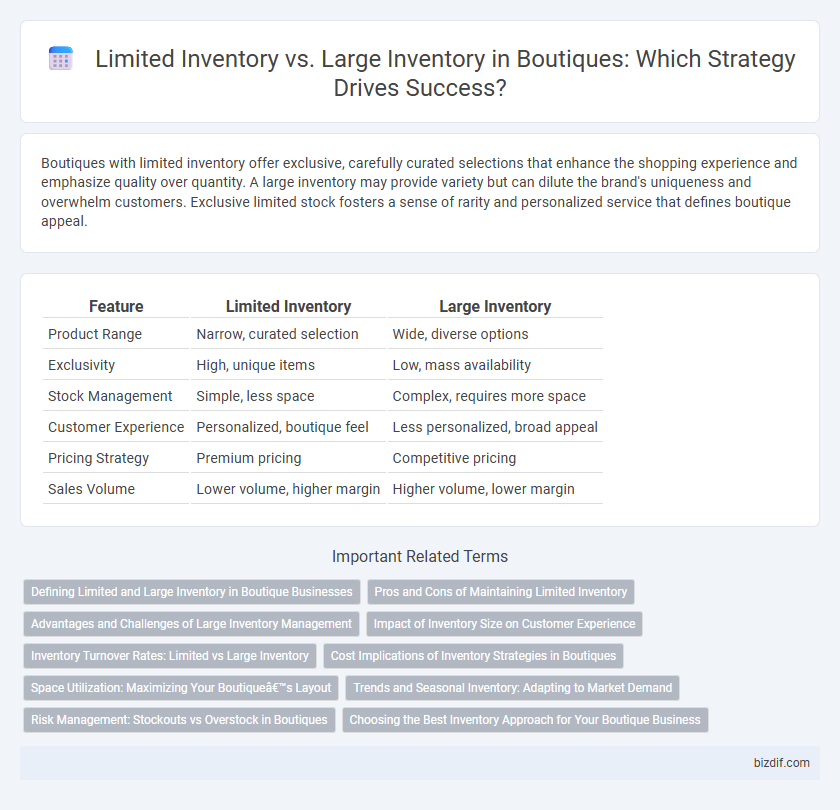Boutiques with limited inventory offer exclusive, carefully curated selections that enhance the shopping experience and emphasize quality over quantity. A large inventory may provide variety but can dilute the brand's uniqueness and overwhelm customers. Exclusive limited stock fosters a sense of rarity and personalized service that defines boutique appeal.
Table of Comparison
| Feature | Limited Inventory | Large Inventory |
|---|---|---|
| Product Range | Narrow, curated selection | Wide, diverse options |
| Exclusivity | High, unique items | Low, mass availability |
| Stock Management | Simple, less space | Complex, requires more space |
| Customer Experience | Personalized, boutique feel | Less personalized, broad appeal |
| Pricing Strategy | Premium pricing | Competitive pricing |
| Sales Volume | Lower volume, higher margin | Higher volume, lower margin |
Defining Limited and Large Inventory in Boutique Businesses
Limited inventory in boutique businesses refers to a curated, small selection of high-quality, unique items that emphasize exclusivity and personalized customer experiences. Large inventory, by contrast, involves a substantial range of diverse products aimed at meeting broad customer preferences and maximizing sales volume. Choosing between limited and large inventory impacts boutique branding, supply chain management, and customer engagement strategies.
Pros and Cons of Maintaining Limited Inventory
Maintaining limited inventory in a boutique enhances exclusivity and reduces storage costs, promoting a curated shopping experience that appeals to trend-conscious customers. This approach minimizes overstock risks and markdowns, improving cash flow and inventory turnover rates. However, limited inventory may lead to stockouts and lost sales opportunities if demand exceeds supply, requiring precise demand forecasting to balance availability with scarcity.
Advantages and Challenges of Large Inventory Management
Large inventory management in boutiques offers the advantage of meeting diverse customer demands with extensive product variety, boosting sales potential and brand presence. However, it challenges businesses with higher storage costs, increased risk of unsold stock, and complex inventory tracking requiring sophisticated management systems. Efficient large inventory control involves balancing stock levels to optimize turnover while avoiding overstocking that can tie up capital and reduce profitability.
Impact of Inventory Size on Customer Experience
Limited inventory in boutiques creates a sense of exclusivity and urgency that enhances customer engagement and perceived value. Small inventories enable personalized service and curated selections tailored to niche preferences, elevating the shopping experience. Large inventories offer variety and comprehensive choices but may lead to decision fatigue, diluting the boutique's unique appeal.
Inventory Turnover Rates: Limited vs Large Inventory
Boutiques with limited inventory typically achieve higher inventory turnover rates due to curated, exclusive selections that encourage faster purchasing cycles. In contrast, large inventory stores often experience slower turnover rates as a wider variety of products dilutes consumer focus and increases holding periods. Efficient inventory turnover in boutique settings enhances cash flow and reduces storage costs, optimizing profitability despite smaller stock volumes.
Cost Implications of Inventory Strategies in Boutiques
Limited inventory in boutiques reduces holding costs, minimizing expenses related to storage, insurance, and markdowns from unsold stock. Large inventory strategies increase capital tied up in products, elevating risks of obsolescence and higher operational costs, but may enhance customer choice and immediate availability. Balancing inventory size directly impacts boutique profitability by influencing cash flow, risk exposure, and merchandise turnover rates.
Space Utilization: Maximizing Your Boutique’s Layout
Limited inventory in boutiques enables optimal space utilization by allowing carefully curated displays that highlight each product's unique appeal, fostering an exclusive shopping experience. Large inventory requires strategic layout planning to prevent overcrowding, ensuring clear pathways and visual hierarchy that guide customers smoothly through diverse product categories. Effective space utilization balances product visibility and customer comfort, directly impacting sales and brand perception.
Trends and Seasonal Inventory: Adapting to Market Demand
Boutiques with limited inventory can quickly adapt to emerging trends and seasonal shifts, offering curated, exclusive pieces that appeal to niche markets. In contrast, large inventory stores leverage volume to stock a broad range of styles, ensuring availability across varying consumer preferences but risking overstock during off-seasons. Strategic inventory management that aligns with fashion cycles and market demand enables boutiques to maximize relevance and minimize excess stock.
Risk Management: Stockouts vs Overstock in Boutiques
Boutiques with limited inventory face a higher risk of stockouts, potentially leading to lost sales and customer dissatisfaction due to exclusive or trendy product demands. Conversely, maintaining a large inventory in boutiques increases the chance of overstock, causing tied-up capital and markdown pressures on slow-moving items. Effective risk management involves balancing inventory size to optimize turnover rates while minimizing losses associated with both stockouts and overstock scenarios.
Choosing the Best Inventory Approach for Your Boutique Business
Selecting the ideal inventory approach for your boutique business hinges on balancing exclusivity with variety; limited inventory enhances brand uniqueness and customer loyalty by offering rare items, while large inventory attracts a broader audience through diverse product options. Analyzing sales data and customer preferences helps optimize stock levels, ensuring efficient inventory turnover and reducing holding costs. Prioritizing niche market demands and supplier reliability further refines inventory strategies, maximizing profitability and brand positioning.
Limited inventory vs Large inventory Infographic

 bizdif.com
bizdif.com